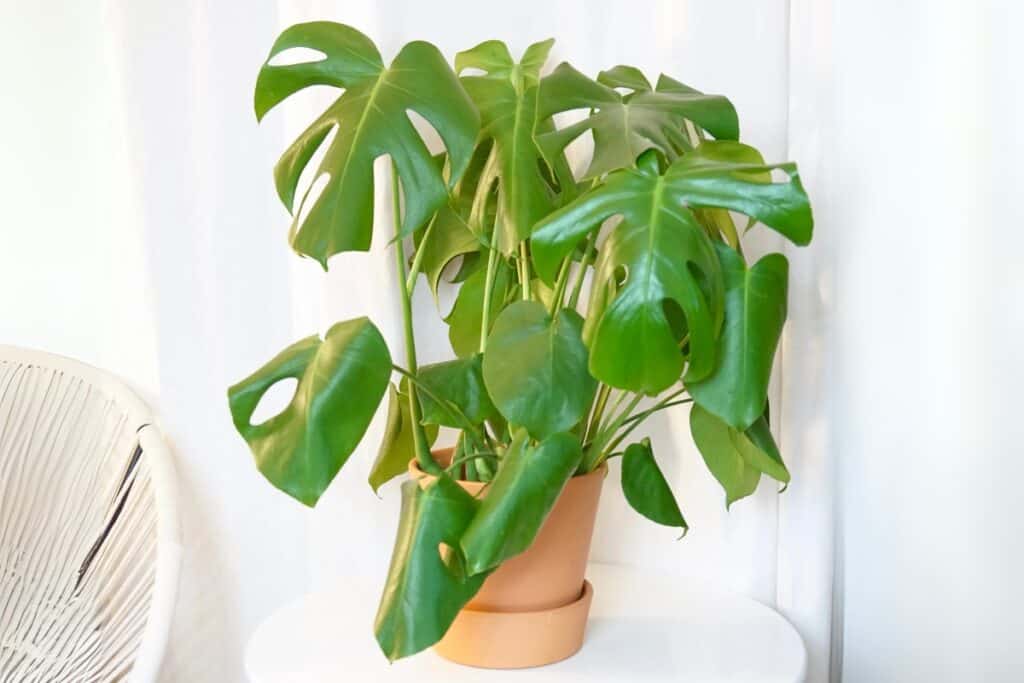Monstera leaves that curl inward, downward, or take on unusual shapes often signal underlying care issues that plant owners can easily overlook. These distinctive foliage changes serve as the plant’s primary communication method, indicating everything from watering problems to environmental stress. While curling might seem alarming at first glance, it typically represents fixable issues rather than permanent damage. Understanding the specific type of curl, its timing, and accompanying symptoms reveals exactly what your Monstera needs to return to its signature split-leaf glory.

Contents
- 1 Watering Imbalances: The Most Common Culprit
- 2 Light Exposure Problems and Their Effects
- 3 Temperature Fluctuations and Plant Stress
- 4 Humidity Requirements for Healthy Growth
- 5 Nutrient Deficiencies and Fertilization Issues
- 6 Pest Infestations That Damage Leaves
- 7 Disease-Related Leaf Curling
- 8 Root Health and Soil Conditions
- 9 Pot Size and Repotting Considerations
- 10 Natural Leaf Development vs. Problem Signs
Watering Imbalances: The Most Common Culprit
Nine out of ten cases of curling Monstera leaves trace back to watering problems, making this the first area every plant parent should investigate. Both underwatering and overwatering create distinct symptoms that savvy gardeners can easily identify.
Underwatered Monsteras develop crisp, wrinkled leaves with yellow or brown spots. The soil feels bone dry beyond the top two inches. Proper watering techniques involve checking moisture levels with your finger or a moisture meter before watering.
Overwatered plants show inward-curling leaves, dark spots, and potentially moldy soil. This occurs when water sits in poorly draining soil, suffocating roots and creating the perfect environment for root rot.

Light Exposure Problems and Their Effects
Where gardeners position their Monstera determines whether leaves unfurl beautifully or curl defensively against harsh conditions. Direct sunlight burns delicate foliage, creating brown scorch marks and protective curling. Light intensity should remain bright but indirect, filtering harsh rays through sheer curtains.
Insufficient light duration weakens growth patterns, while excessive exposure triggers stress responses. The sweet spot exists near east-facing windows or several feet from south-facing glass. Monitor leaf color changes – pale green indicates too little light, while crispy brown edges signal overexposure. Moving plants immediately prevents permanent damage to developing leaves.
Temperature Fluctuations and Plant Stress
Temperature swings act like invisible assassins, slowly damaging Monstera leaves through repeated stress cycles. These tropical plants show remarkable temperature sensitivity, thriving between 65°F and 85°F. When temperatures drop below 50°F, leaves curl defensively, protecting themselves from cellular damage.
Draft exposure creates particularly harmful conditions, as cold air streams disrupt the plant’s thermal equilibrium. Heating vents, air conditioners, and open windows near your Monstera can trigger this stress response. Even minor fluctuations of 10-15 degrees can cause noticeable leaf curling within days.
Monitor your plant’s location carefully, checking for temperature consistency throughout different times of day.
Humidity Requirements for Healthy Growth
When humidity levels drop below ideal ranges, Monstera leaves curl inward as their natural defense mechanism against moisture loss. These tropical plants thrive in 60-80% humidity, considerably higher than most indoor environments.
Effective humidity solutions include placing plants on pebble trays filled with water, grouping multiple plants together, or investing in a quality humidifier. Regular humidity monitoring with a hygrometer guarantees prime conditions year-round.
Low humidity stress manifests as curled, crispy leaf edges and slower growth rates. Simply misting leaves provides temporary relief, but consistent environmental adjustments deliver lasting results for healthy, unfurled foliage.
Nutrient Deficiencies and Fertilization Issues
Proper nutrition plays a fundamental role in preventing Monstera leaf curl, as these plants require consistent feeding throughout their growing seasons. Nutrient absorption becomes compromised when essential elements like nitrogen, phosphorus, and potassium are depleted from soil.
Nitrogen deficiency causes lower leaves to yellow and curl, while phosphorus shortage stunts root development. Potassium deficiency creates curling at leaf tips with discoloration.
Fertilizer types vary from liquid to granular options, with specialized Monstera blends available. Feed monthly during spring and summer using balanced fertilizers. However, overfertilization also triggers leaf curling, so moderation remains key for healthy growth patterns.
Pest Infestations That Damage Leaves
Tiny invaders can wreak havoc on Monstera leaves, causing them to curl, discolor, and eventually deteriorate if left unchecked. Common pest types include spider mites, aphids, and mealybugs, each leaving distinct damage patterns on foliage.
Spider mites create fine webbing and stippled leaves, while aphids cluster on new growth, secreting sticky honeydew. Mealybugs appear as white, cotton-like masses in leaf joints and stems.
Effective treatment methods involve insecticidal soap or neem oil applications every 5-7 days. Quarantine affected plants immediately to prevent spreading. Regular leaf inspections help catch infestations early, when treatment methods prove most successful.
Pathogens lurking in soil and air can trigger serious leaf curling that differs markedly from pest damage or environmental stress. Fungal infection symptoms include dark spots, unusual curling patterns, and rapid leaf decay that spreads systematically throughout the plant. Bacterial diseases create similar curling but often produce water-soaked lesions and foul odors.
Disease prevention strategies focus on maintaining proper air circulation, avoiding overhead watering, and removing affected foliage immediately. Inspect plants weekly for early detection, quarantine suspicious specimens, and apply fungicides when necessary. Well-draining soil and consistent care routines considerably reduce disease risks.
Root Health and Soil Conditions
While surface symptoms often steal attention, underground problems frequently cause the most stubborn leaf curling issues in Monsteras. Root inspection during repotting reveals damaged, rotting, or circling roots that can’t properly absorb nutrients and water.
Compacted soil creates another hidden culprit. Poor soil aeration restricts root growth, leading to waterlogged conditions that suffocate roots. Check for roots growing through drainage holes, indicating cramped conditions.
Fresh, well-draining potting mix restores proper soil structure. Trim any black, mushy roots before repotting into containers with adequate drainage holes. Quality soil provides the foundation for healthy leaves.
Pot Size and Repotting Considerations
Most Monstera owners discover their plant’s pot has become too small when leaves begin curling despite perfect watering and lighting conditions. Roots circling the drainage holes signal it’s time for an upgrade.
Proper pot selection means choosing containers one to two inches larger in diameter. Cramped roots can’t absorb nutrients efficiently, causing stress-induced curling. Fresh soil provides essential nutrients while improving soil aeration around compressed root systems.
During repotting, gently tease apart circled roots and trim any damaged sections. Well-draining potting mix prevents future waterlogging issues that contribute to leaf problems.
Natural Leaf Development vs. Problem Signs
Understanding the difference between healthy leaf development and stress responses prevents unnecessary panic among plant owners. New Monstera leaves naturally emerge twisted, curled, and light green in color. This natural leaf development occurs as leaves slowly unfurl over several days or weeks, gradually darkening to their mature green shade.
However, curling signs indicating problems appear differently. Mature leaves that suddenly curl inward, develop brown edges, or show yellowing typically signal stress from watering issues, light problems, or environmental factors. Healthy new growth maintains consistent unfurling patterns, while stressed leaves exhibit irregular curling with accompanying discoloration or damage.
